
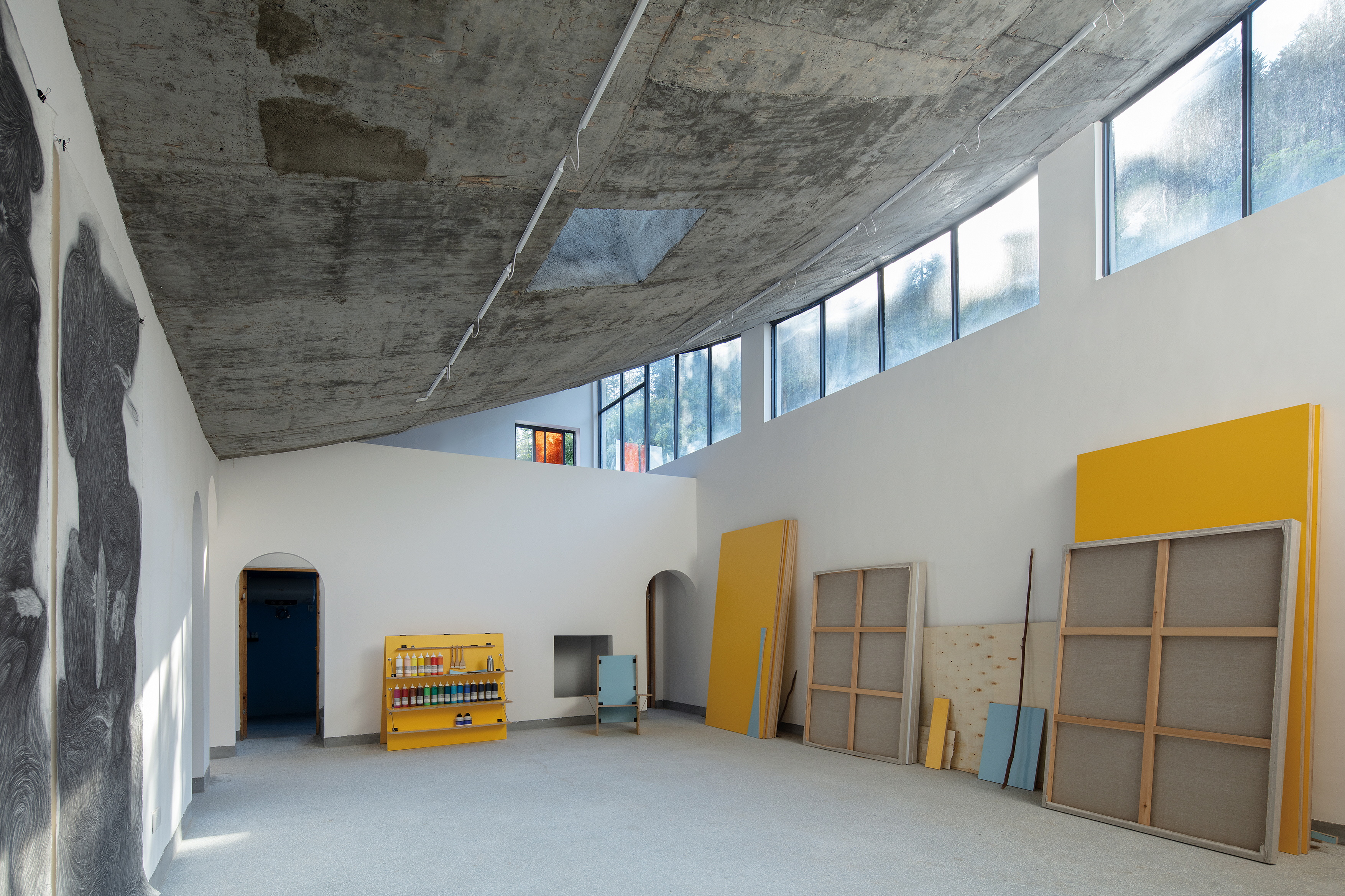
项目地点 江西抚州
设计单位 跳房子建筑工作室
建设时间 2021年
建筑面积 310平方米
撰文 王田田
本文文字由设计单位提供。
01
掀起房子的四角
想象一间两层房子的四角被掀起。更多的光便照了进来,层高也变得模糊,有的房间有两层通高,有的房间有一层半那么高,还有的房间只有贴近屋顶的半层,自然地成为了客厅、画室、檐廊或者阁楼......
Imagine a two-storey house, with its four rooftop corners lifted up. More light is let in; the height of interior space becomes indefinite – some rooms are two storeys high, some one and a half, and some close to the top ceiling are only half storey high, and these spaces naturally transform into a living room, an art studio, a loggia, or an attic…


屋顶自然形成了一处由四条曲线围合出来的双曲面露台,像一个面向天空敞开的院子,院子的中间是晴天夜晚人们乘凉望月的地方,也是雨天雨水汇聚的地方,这里隐藏着四处排水点,将雨水从屋内引向屋外。
The roof, defined by four curves, transforms into a patio featuring a double-curved structure, just like a courtyard opening up towards the sky. People can get together here on a clear summer night to enjoy the bright moon and the cool; on a wet day, this is also where rain gathers and gets drained out of the house from four waterspouts.


02
画室+住宅
这是位于江西省抚州市芦坑村里坳小组的一间画室,主人是北漂多年后又沪漂了几年的艺术家朋友竹子。可能是因为漂得太久,所以希望在老家盖一间画室,每年可以选择一定时间段回家创作,同时满足父母的日常居住以及两个姐姐一家回家过节团聚的需要。
This is an art studio located in Li'ao Xiaozu, Lukeng Village, Fuzhou, Jiangxi Province. Zhuzi, the owner, is a friend of mine who had been a ‘Beijing drifter’ for years before he continued ‘drifting’ to Shanghai and spent another few years there. Years of migration contributed to the idea of building an art studio in his hometown – which would allow him to spend some time of the year at home producing art works, provide his parents with a new home and accommodate his two sisters and their families when the family reunites.



03
乡村生长极简史
芦坑村是竹子出生和成长的地方,在深山里,交通并不便利,和很多山里的村子一样,它有着自己的小环境。画室所在的里坳小组几十栋房子多依山而建、面田而居,现状的居住类型多为公元2000年以前建造的一字型二层楼房,中段还保存着一栋已无人居住的合院式传统老宅,以及2000年后建造了一些新式外贴瓷砖的农居房,这三个时期的房子记录这个村子的生长简史。
Lukeng Village is where Zhuzi was born and grew up. It is in a mountainous area that is not easily accessible. Like many other Chinese mountain villages, Lukeng has a unique surrounding. The art studio is situated in Li’ao Xiaozu[1] among dozens of other houses, most of which back onto the mountain and face the farmland. Currently the typical dwellings there are two-storey houses with a linear layout that were built before 2000. In the centre of the Xiaozu lies an uninhabited traditional courtyard house. There are also new style houses built after the millennium year featuring ceramic tiled exterior walls. These small buildings representing three different periods are a record of the village’s development.
如果竹子没有回家盖画室的想法,这个村子应该会继续以新式农居房慢慢替代上世纪住宅的方式,安静地更新生长,或者随着常住人口的减少而慢慢停止生长。画室的出现应该是这个村子生长史上的一次美好的意外,我们希望它在这片乡村生长史的水面上激起一点涟漪。
If Zhuzi hadn’t had the idea of building an art studio back home, the village would have kept evolving, with new houses gradually replacing those from the last century; or the village would have started to wither as the population is declining. Hence, the emergency of this art studio was a beautiful surprise in the village’s evolution. We hope to ripple the peaceful lake of the village’s history.

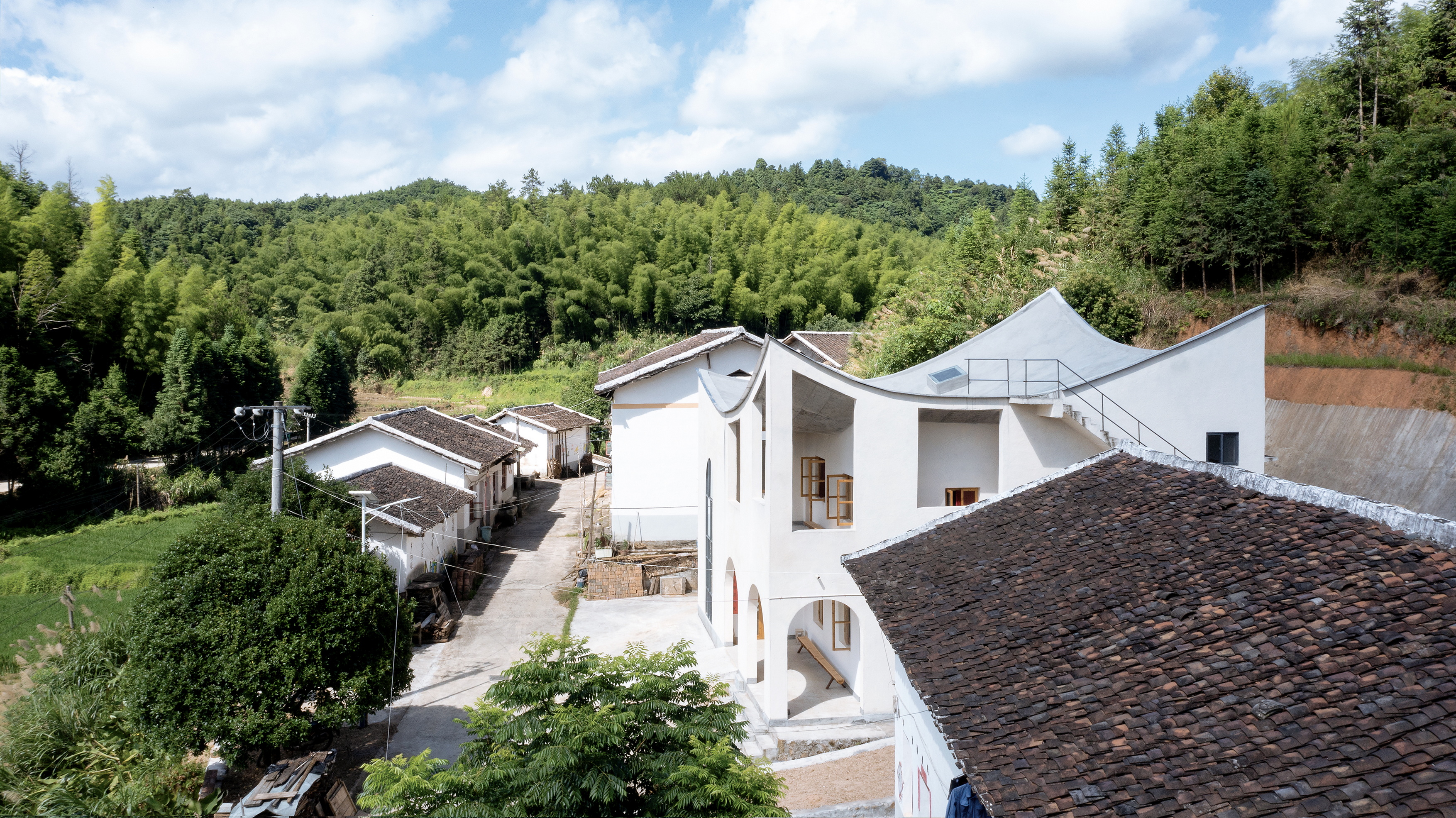

04
从“画室+住宅”
到藏着住宅和画室的小房子
在设计之初,我们并没有太多先入为主的设想,是延续村子的现状还是置入一个天外来物?而竹子家人的居住需要让它不可能是一个天外来物,画室的存在又让它不可能完全融入这片村落。
At the beginning we had few preconceived ideas regarding whether to have the house blend in the village’s environment or to insert an abrupt, alien object into it. But since Zhuzi’s parents will be the permanent residents, ruling out the ‘alien object’ option; on the other hand, the existence of an art studio in a rural area making it impossible to truly blend in.

从最初头脑风暴到最终的方案,我们设想了很多种可能。方案从当地语言与画室形态,以及住宅功能与画室功能的拼贴,到越来越接近于一个边界清晰的有趣模型,更多地消解了关于当地的具体印象,最后拼贴感越来越弱。就像一个艺术家创作之初需要感受万物、情感丰富,但最终的作品还得是单纯的、直接的、边界清晰的。
From the initial brainstorming to our finalised proposal, we imagined many possibilities. Our idea started from a collage of the local architectural language, the form of the studio, and requirements for daily living and creating art works, and ended up an intriguing model with clear boundaries that has dissolved the concrete impressions of the village and weakened the sense of collage – just the same as how an artist works: they need to have their perception fully loaded with stimulations from everything and begin their work in great passion, but the fruit should be pure, definite, and clearly-bounded.



在我们看来,竹子回老家建造画室,是一件有浪漫气质的事,于是我们给予它一个有浪漫气质的屋顶,来涵盖生活空间的日常性和创作空间的特殊性,以及两者之间的连接。
From the way we saw it, Zhuzi’s decision to build his studio in his hometown was romantic, so we gave the building a romantic roof to cover and connect the ordinariness of daily life and the uniqueness of art practice.

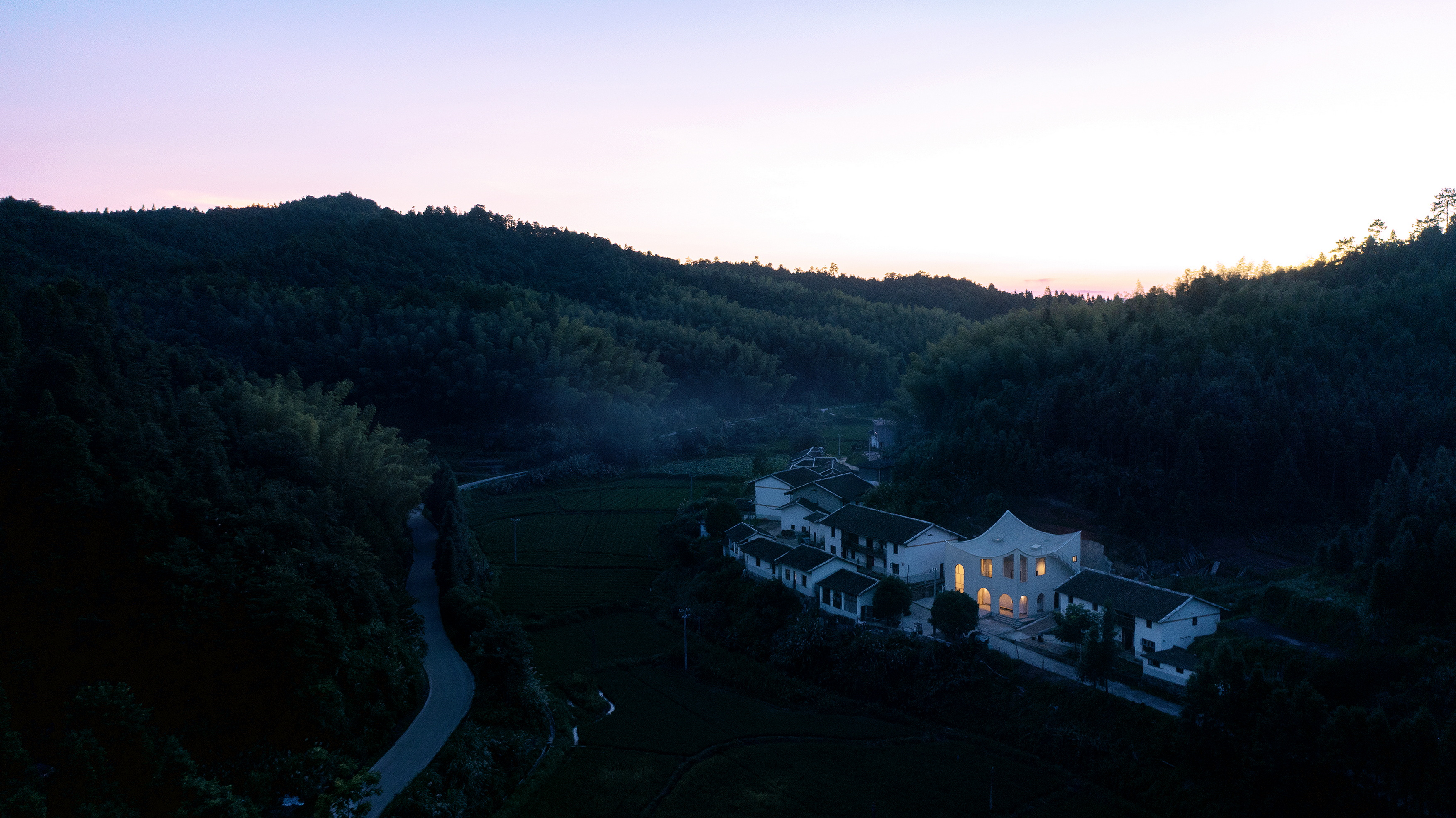
05
连续的公共空间与6个小房间
比起卧室,竹子更在意公共空间的大小,设计之初他给了我一张照片,是他每天路过的一栋深檐廊的西式建筑(上海武康路原意大利领事府邸)的照片,他希望自己的新房子也能有比常规乡村住宅更深更大的檐廊,这样可以为村民和家人提供乘凉、聊天的空间。
Compared with the sizes of bedrooms, the size of common space is more valuable to Zhuzi. He showed me a reference photo of a modern western style building in Wukang Rd, Shanghai, which was the official residence of the Italian consul general in the 1930s. Zhuzi passed by the building when he commuted to work and was fascinated by its characteristic loggias, so he hoped that his new house would have a more spacious loggia wider than that of normal rural houses, enabling the family to enjoy the cool or socialise with neighbours.



这个村小组目前常住的人口只有10个,所有的年轻人都在外地,对于还留在村子里的老人和孩子来说,可以交流的公共场所尤为重要;对于很少回家团聚的竹子一家人来说,可以交流的空间似乎也要比私人空间更重要。
Currently there are only ten permanent residents in Li’ao Xiaozu as all young adults are ‘drifting’ to larger towns or cities. For seniors and young children staying here, a common area for communicating is important. In Zhuzi’s case, family reunions are rare and precious, so the space for all outweighs spaces for one.



于是我们以檐廊为起点,设计了一系列公共空间,檐廊连接着两层通高的客厅,客厅连接着画室,画室连着阁楼、二层檐廊以及屋顶,形成了连续公共空间的系统。
We therefore designed a sequence of common spaces starting from a loggia connected with the two storeys high living room, which then joins the studio that extends to an attic, the first-floor loggia, and the roof top, forming a continuous common space system.




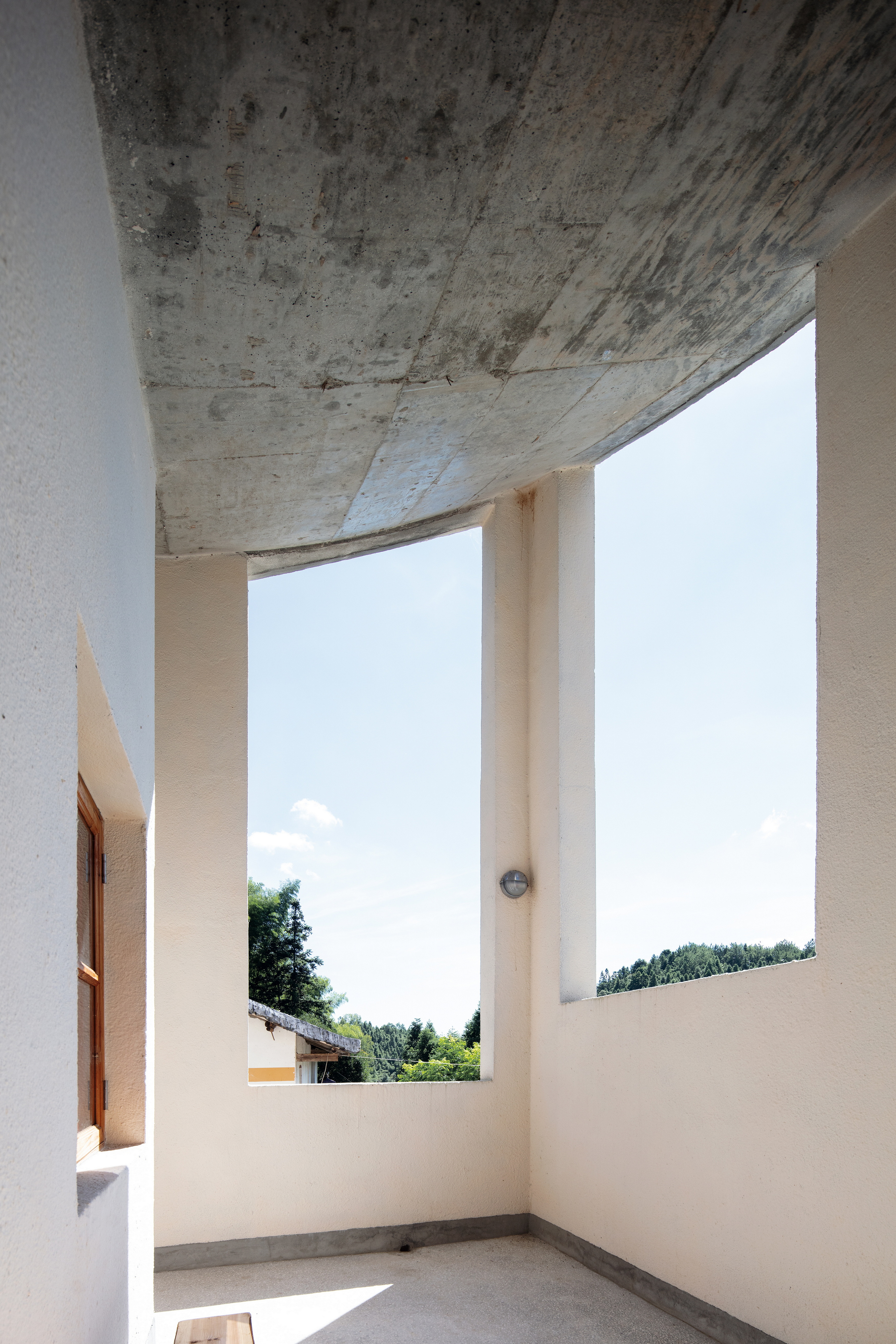

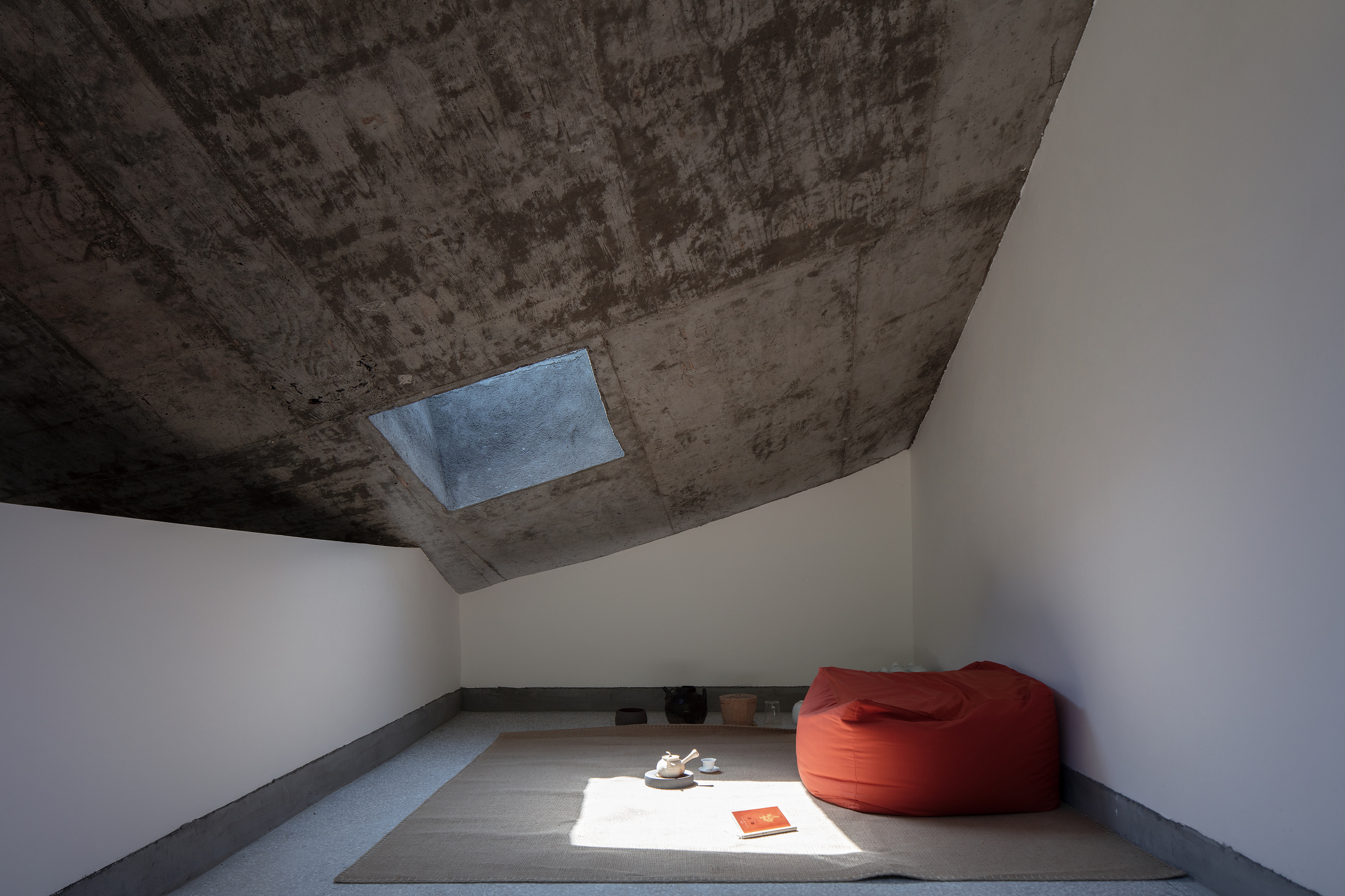
居住空间中的卧室被压缩成6个小房间及其他辅助房间,在边界清晰的外壳里折叠着一组连续的公共空间,可以通向6个不同的小房间,屋顶之下藏着一个通透的小世界。
Living areas have been squeezed into six smaller rooms and some other auxiliary rooms. Inside the clearly defined shell folds this continuous sequence of common spaces that leads to six distinct small rooms, forming a tiny, airy world hidden under the roof.



06
建造
建造这个房子对于当地人来说是个新鲜事儿,也不是件易事。参与建造的是邻村的师傅,主要负责的两位师傅一位年长、一位年轻,年长的活儿好,年轻的能看懂图纸,善于沟通。竹子父亲管理施工的同时也亲自参与了建造。这个房子在预算极其有限的情况下能建成离不开他们的付出。
The construction seemed novel to local villagers, and it was difficult. The construction labours were from an adjacent village, and the team was led by an elderly man and a young lad. The senior builder was experienced and demonstrated craftsmanship while the junior could read the drawings and was a good communicator. Zhuzi’s farther took the role of project manager and laid his hands on some construction jobs. Their efforts were crucial to the completion of this project, especially when the budget was tight.
为了方便师傅们直观地理解方案,除了施工图,我们还分别3D打印了建筑模型和结构模型放在现场。最难建造的是屋顶,主要是支模和浇筑难,对于只做过平屋顶和坡屋顶的师傅们来说,双曲屋顶一下多了几十个定位点,难度自然提升了不少。
To make it easier for builders to fully understand the design in a straightforward way, we provided a 3D-printed model on top of technical drawings on the site. Constructing the rooftop, especially when it came to placing formwork and pouring concrete, was apparently the trickiest part. Unsurprisingly, these builders, who only had had experience in constructing flat or sloped roofs, found it challenging to manage the extra dozens of alignments brought about by the double-curved roof.


当然我们也根据当地施工的实际条件适当地调整了设计,比如原来我们是用方格定位屋顶的标高,跟师傅讨论后改成了根据现成的旧模板的尺寸来定位屋顶的标高,更便于施工也节省造价。比如原方案北侧尖角起翘更高,浇筑时没有混凝土浇灌车,只能靠人工推车,而尖角太高,车子就推不上去;加上出于造价的考虑,支模的立柱用的都是木柱而非钢柱,木柱高度不够,拼接的话强度不够,基于上述两点原因我们就降低了北侧尖角的高度。虽然北高南低的态势有所减弱,但更符合施工的实际情况。
We certainly adjusted the design as feedbacks to all the limitations on site. For example, at first we projected the roof top to a plan with grid lines and marked heights of different points of the rooftop that correspond to the crossing points on the grid, but after discussions with the builders, we decided to determine the heights according to the sizes of molds at hand, which facilitated the construction and cost less. For example, the north corner was expected to be higher in our initial design, but without a concrete mixer truck, it was impossible to transport concrete to that height by a manually operated trolley. Besides, the budget only allowed us to use wooden poles rather than steel ones to support the formwork, but the wooden poles were not long enough, nor strong enough when connected. With such issues entering the equation, we lowered the height of the north corner. It somewhat sacrificed the ideal higher-in-the-north-than-south characteristic of form but was a more holistic and practical move that was consistent with the conditions.
经过施工中的讨论和随机应变,最终呈现的是一个有新意,同时又包含着乡村特有粗野感的小房子。屋顶浇筑当天,我们感觉全村的、邻村的人们都来帮忙了,因为没有混凝土浇灌车,又需要一天内把屋顶浇完,所以大家齐心协力、共同造屋,场面感人。
Our discussions and flexibility throughout the constructing process have led up to a little house that is novel while also has a special charm of the rustic ‘brutalism’. On the day the rooftop was cast, people from not only Lukeng but also neighbouring villages all came to help – as the job had to be finished in a day while there was no mixer truck. The scene that they worked as a team was quite touching and memorable.

07
房子盖好后
房子盖好后,竹子亲自在画室制作了一批可爱的家具,从床、桌子、凳子、灯具到工具架,家具中局部出现的弧线,说是为了呼应屋顶的曲线。
When the construction was completed, Zhuzi started to make a series of lovely furniture in his new studio, ranging from beds, tables, stools, lights and tool shelves. He said the curves in the furniture echo the curves of the roof.
房子盖好后,竹子为房子起了一个名字,叫“反曲小筑”,并写了一副对联,“反观常物穷思变,筑就乡村新容颜”。成为独立艺术家的竹子在村子里多少有些反常,这幅对联应该就是他内心的独白,所谓的反常对他来说可能就是思考角度的不同,是一种反思。他想通过建筑师把自己的反常以一种可见的方式表达出来,反常便有了积极的意义。作为建筑师,一座反常的房子可能意味着有趣,为日常生活置入一些可以遐想的空间。
When the construction was completed, Zhuzi came up with a name for the house – ‘Fanqu Xiaozhu’, i.e. ‘a small house with a curving roof’, and composed a couplet for it, which can somewhat translate to ‘a reflection on common things results in new ideas; an art studio breathes life into an old village’. As an independent artist, Zhuzi seems abrupt in the village, and this couplet is just his interior monologue. For him, such abruptness is a different perspective of thinking, an approach of reflection; hence he hoped that the architect could give form to his abruptness and turn it into a positive power. As an architect, I see an abrupt house as intriguing because it opens up space for imagination in daily life.


房子盖好后,过年竹子家邀请亲戚们团聚吃饭,办了八桌酒席,画室成了宴席的大厅,渐渐淡去的年味在那一刻似乎又回来了。
When the construction was completed, Zhuzi’s family entertained relatives to dinner in the new house. The host set up eight tables, and the studio was temporarily used as a hall. At the moment, the atmosphere of a lively traditional new year was back.
房子盖好后,为了拍摄,我、竹子以及摄影师夏至去住了两天,我们仨想聊天的时候就随时找地儿聚在一起,檐廊、餐厅、画室、客厅、树下或者屋顶,想独处的时候也能随时找到各自的角落,很自在。
When the construction was completed, Zhuzi, photographer Xia Zhi and I stayed in the new house for a couple of days to take some photos. Whenever we were up to a conversation, there was always a cozy spot for us to chill together – the loggia, the dining room, the studio, the living room, under the tree or up on the rooftop; and when we wanted to spend some time alone, we could also easily find some personal space, which was relaxing.
那时正值夏日,村子里安静得只剩下蝉鸣、鸟叫甚至微风吹动树叶的声音,时间变得无比缓慢。发呆的时候我甚至有些恍惚,时而觉得自己身处平常恬淡的乡间,可能因为有了这个房子的存在,时而又觉得自己进入了童话里的夏天,稻田、西瓜、老人、小孩、土狗、圆门洞、竹子的画、曲屋顶、屋顶下筑窝的燕子以及上弦月......
It was in the summer. The village was so peaceful and quiet that the only sounds noticeable were cicadas chirping, birds twittering, and breezes rustling through trees; time seemed to stretch and become very slow. Sometimes when I unwound and let my mind drift away, I felt as if I were in the peaceful countryside, and probably because of this house, at some other times it felt like I entered the summer in a fairy tale, where there were paddy fields, watermelons, the old and the young, local dogs wandering about, moon gates, Zhuzi’s paintings, curving roofs, swallows nesting under eaves, and the crescent…

设计图纸 ▽




Note:[1]Xiaozu is an administrative division in China below Cun (village). Typically a Xiaozu is a small, self-led community.
完整项目信息
项目名称:乡村画室
项目类型:建筑
项目地点:江西省抚州市芦坑村里坳小组
设计单位:跳房子建筑工作室
主创建筑师:王田田、罗雅琴
业主:竹子
建成状态:建成
设计时间:2019年
建设时间:2019-2021年
建筑面积:310平方米
结构:周建成
家具和灯具设计:竹子
施工:竹子父亲、小柴和小根师傅团队
材料:清水混凝土、涂料、实木、水泥、水磨石
摄影师:夏至、王田田
翻译:滑琪
版权声明:本文由跳房子建筑工作室授权发布。欢迎转发,禁止以有方编辑版本转载。
投稿邮箱:media@archiposition.com
上一篇:远方的家:杭州市威雅实验学校 / 中国联合工程有限公司
下一篇:城镇浓缩体:伊柳埃卡礼堂 / Magén Arquitectos